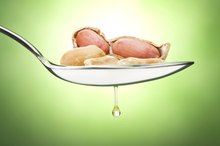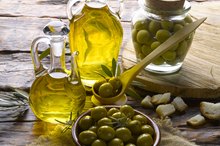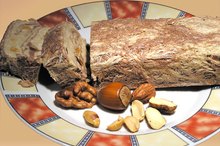What does fact checked mean?
At Healthfully, we strive to deliver objective content that is accurate and up-to-date. Our team periodically reviews articles in order to ensure content quality. The sources cited below consist of evidence from peer-reviewed journals, prominent medical organizations, academic associations, and government data.
- Oregon State University Linus Pauling Institute: Vitamin K
- Harvard Health Publications: Listing of Vitamins
- MayoClinic.com: Olive oil: What are the health benefits?
The information contained on this site is for informational purposes only, and should not be used as a substitute for the advice of a professional health care provider. Please check with the appropriate physician regarding health questions and concerns. Although we strive to deliver accurate and up-to-date information, no guarantee to that effect is made.
Content of Vitamin K in Olive Oil
Olive oil is a type of vegetable oil made from olives used in cooking as well as other applications outside of the culinary arts. Although fats should be consumed sparingly, olive oil is a good choice as it offers several health benefits 6. It is high in healthy fats and contains a good amount of vitamin K. Vitamin K is an important fat-soluble vitamin required for the blood clotting process.
Content and Dietary Reference Intakes
Vitamin K is the most abundant vitamin in olive oil with 1 tbsp. or 13 g providing 10 percent daily value of vitamin K, based upon a 2,000 calorie diet, according to Calorie Lab. For more clarification, a teaspoon of olive oil provides 3.4 percent daily value of vitamin K and a cup provides 162.5 percent. The Institute of Medicine recommends 120 mcg and 90 mcg of vitamin K per day for adult men and women, respectively. Adolescents and teenagers ages 9 to 18 should consume 60 to 75 micrograms per day and children ages 1 to 8 should consume 30 to 55 mcg. Infants up to one year of age need between 2 and 2.5 mcg per day.
- Vitamin K is the most abundant vitamin in olive oil with 1 tbsp.
- The Institute of Medicine recommends 120 mcg and 90 mcg of vitamin K per day for adult men and women, respectively.
Forms of Vitamin K
How Many Calories Are in Frozen Yogurt Compared with Ice Cream?
Learn More
Plants synthesize vitamin K1 and bacteria produce vitamin K2. Vitamin K3 is a synthetic or man-made version of the vitamin.
Functions of Vitamin K
Vitamin K plays an important role in the coagulation process and is often referred to as the blood-clotting vitamin. The coagulation or clotting cascade utilizes seven vitamin-K dependent clotting factors to form a blood clot that stops bleeding. Vitamin K also supports healthy bones and may help prevent hip fractures, according to Harvard Health Publications 5.
Considerations
Soybean Oil Nutrition Facts
Learn More
Of the common vegetable oils, olive oil contains the least amount of vitamin K with 8.1 mcg per tbsp. as compared to canola or soybean oil, which contain 16 and 25 mcg per tbsp. respectively, according to the Linus Pauling Institute 3. Olive oil does contain a good amount of healthy fats, specifically monounsaturated fats, which may help lower LDL or bad cholesterol levels, but it should be used sparingly and in place of unhealthier fats such as butter. Although vitamin K deficiency is rare, a variety of other, healthier foods contain higher amounts of vitamin K as compared to olive oil.
- Of the common vegetable oils, olive oil contains the least amount of vitamin K with 8.1 mcg per tbsp.
- as compared to canola or soybean oil, which contain 16 and 25 mcg per tbsp.
Related Articles
References
- Oregon State University Linus Pauling Institute: Vitamin K
- University of Maryland Medical Center: Vitamin K
- MayoClinic.com: Olive oil: What are the health benefits?
- Holick MF, Gordon CM. Patient Guide to Vitamin D Deficiency. The Journal of Clinical Endocrinology & Metabolism. 2011;96(7):1-2. doi:10.1210/jcem.96.7.zeg33a
- Sunyecz JA. The use of calcium and vitamin D in the management of osteoporosis. Ther Clin Risk Manag. 2008;4(4):827-836. doi:10.2147/tcrm.s3552
- Giovannucci E, Liu Y, Hollis BW, Rimm EB. 25-hydroxyvitamin D and risk of myocardial infarction in men: a prospective study. Arch Intern Med. 2008;168(11):1174-1180. doi:10.1001/archinte.168.11.1174
- Gorham ED, Garland CF, Garland FC, et al. Optimal vitamin D status for colorectal cancer prevention: a quantitative meta analysis. Am J Prev Med. 2007;32(3):210-216. doi:10.1016/j.amepre.2006.11.004
- Lappe JM, Travers-Gustafson D, Davies KM, Recker RR, Heaney RP. Vitamin D and calcium supplementation reduces cancer risk: results of a randomized trial. The American Journal of Clinical Nutrition. 2007;85(6):1586-1591. doi:10.1093/ajcn/85.6.1586
- Prentice RL, Pettinger MB, Jackson RD, et al. Health risks and benefits from calcium and vitamin D supplementation: Women’s Health Initiative clinical trial and cohort study. Osteoporos Int. 2013;24(2):567-580. doi:10.1007/s00198-012-2224-2
- Urashima M, Segawa T, Okazaki M, Kurihara M, Wada Y, Ida H. Randomized trial of vitamin D supplementation to prevent seasonal influenza A in schoolchildren. Am J Clin Nutr. 2010;91(5):1255-1260. doi:10.3945/ajcn.2009.29094
- Salehpour A, Hosseinpanah F, Shidfar F, et al. A 12-week double-blind randomized clinical trial of vitamin D₃ supplementation on body fat mass in healthy overweight and obese women. Nutr J. 2012;11:78. doi:10.1186/1475-2891-11-78
- Carrillo AE, Flynn MG, Pinkston C, et al. Impact of vitamin D supplementation during a resistance training intervention on body composition, muscle function, and glucose tolerance in overweight and obese adults. Clin Nutr. 2013;32(3):375-381. doi:10.1016/j.clnu.2012.08.014
- Marcinowska-Suchowierska E, Kupisz-Urbańska M, Łukaszkiewicz J, Płudowski P, Jones G. Vitamin D Toxicity-A Clinical Perspective. Front Endocrinol. 2018;9:550. doi:10.3389/fendo.2018.00550
- Ross AC, Manson JE, Abrams SA, et al. The 2011 report on dietary reference intakes for calcium and vitamin D from the Institute of Medicine: what clinicians need to know. J Clin Endocrinol Metab. 2011;96(1):53-58. doi:10.1210/jc.2010-2704
- Bouillon R, Van Schoor NM, Gielen E, et al. Optimal vitamin D status: a critical analysis on the basis of evidence-based medicine. J Clin Endocrinol Metab. 2013;98(8):E1283-E1304. doi:10.1210/jc.2013-1195
- American Academy of Dermatology. Position Statement of Vitamin D. 2010.
- Taksler GB, Cutler DM, Giovannucci E, Keating NL. Vitamin D deficiency in minority populations. Public Health Nutr. 2015;18(3):379-391. doi:10.1017/S1368980014000457
- Holick MF, Binkley NC, Bischoff-Ferrari HA, et al. Evaluation, treatment, and prevention of vitamin D deficiency: an Endocrine Society clinical practice guideline. J Clin Endocrinol Metab. 2011;96(7):1911-1930. doi:10.1210/jc.2011-0385
- Cannell JJ, Vieth R, Umhau JC, et al. Epidemic Influenza and Vitamin D. Epidemiol Infect. 2006; 134:1129-40.
- Carrillo AE1, Flynn MG, Pinkston C, Markofski MM, Jiang Y, Donkin SS, Teegarden D. Impact of Vitamin D Supplementation During a Resistance Training Intervention on Body Composition, Muscle Function, and Glucose Tolerance in Overweight and Obese Adults. Clin Nutr. 2013 Jun;32(3):375-81. doi: 10.1016/j.clnu.2012.08.014. Epub 2012 Aug 31.
- Ginde AA, Mansbach JM, Camargo CA, Jr. Association Between Serum 25-Hydroxyvitamin D Level and Upper Respiratory Tract Infection in the Third National Health and Nutrition Examination Survey. Arch Intern Med. 2009; 169:384-90.
- Giovannucci E, Liu Y, Hollis BW, Rimm EB. 25-hydroxyvitamin D and Risk of Myocardial Infarction in Men: a Prospective Study. Arch Intern Med. 2008; 168:1174-80.
- Gorham ED, Garland CF, Garland FC, Grant WB, Mohr SB, Lipkin M, Newmark HL, Giovannucci E, Wei M, Holick MF. Optimal Vitamin D Status for Colorectal Cancer Prevention: a Quantitative Meta-analysis. Am J Prev Med. 2007 Mar;32(3):210-6.
- Heaney, Robert P. “The Vitamin D Requirement in Health and Disease.” The Journal of Steroid Biochemistry & Molecular Biology 97 (2005):13-9.
- Holick MF. Vitamin D. In: Shils M, Olson J, Shike M, Ross AC, ed. Modern Nutrition in Health and Disease, 9th ed. Baltimore: Williams and Wilkins, 1999.
- National Institutes of Health Office of Dietary Supplements. Vitamin D: Dietary Supplement Fact Sheet. University of Ottawa Evidence-based Practice Center. Effectiveness and Safety of Vitamin D in Relation to Bone Health. Agency for Healthcare Research and Quality. Aug 2007: 07-E013.
- Salehpour A1, Hosseinpanah F, Shidfar F, Vafa M, Razaghi M, Dehghani S, Hoshiarrad A, Gohari M. A 12-week Double-blind Randomized Clinical Trial of Vitamin D₃ Supplementation on Body Fat Mass in Healthy Overweight and Obese Women. Nutr J. 2012 Sep 22;11:78. doi: 10.1186/1475-2891-11-78.
- Urashima M, Segawa T, Okazaki M, Kurihara M, Wada Y, Ida H. Randomized Trial of Vitamin D Supplementation to Prevent Seasonal Influenza A in Schoolchildren. Am J Clin Nutr. 2010 91:1255-60. Epub 2010 Mar 10.
- Wilkins, Consuelo H. and Yvette I. Sheline, et al. “Vitamin D Deficiency Is Associated with Low Mood and Worse Cognitive Performance in Older Adults.” American Journal of Geriatric Psychiatry 14 (2006): 1032-40.
Writer Bio
Jason Dority has been writing health-related articles and developing community resources for healthier lifestyles since 2007. He currently works for the Indiana University School of Medicine's Diabetes Translational Research Center. Dority holds a Master of Science in biology from Indiana University.









